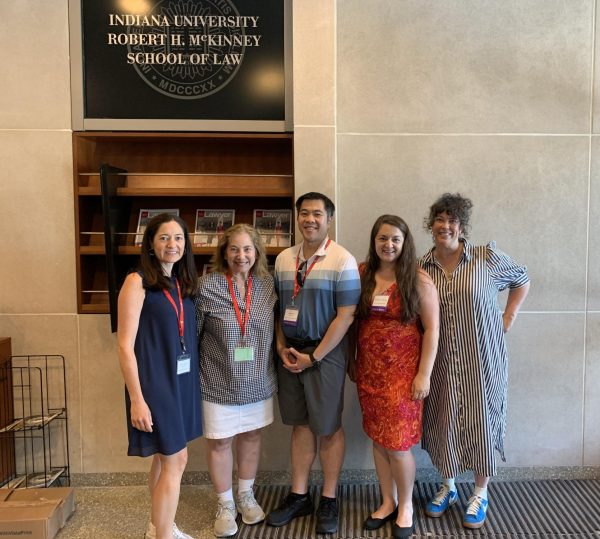Opinion: Russia’s ASAT Test and the Development of Space Law
On November 15, Russia launched a direct ascent anti-satellite (ASAT) missile that deliberately struck Cosmos-1408, one of its own satellites that had become inoperable years ago. Massing at about 2,000 kilograms and with an original orbital altitude of about 480 kilometers, Cosmos-1408 was blown into thousands of pieces, about 1,500 of which will be trackable by ground stations. The debris field is an expanding cloud that continues to orbit the Earth both above and below the original altitude of Cosmos-1408, putting the International Space Station (ISS) at risk. (Regarding the original risk to the ISS, see Jonathan McDowell’s visualization here).
While the safety of the ISS and its crew were of immediate concern, debris from the ASAT test could pose additional dangers. Any pieces colliding with satellites could generate more out-of-control debris that would further degrade the orbital environment and increase the risks to satellites and crewed vehicles. Given these possibilities, did Russia act lawfully when conducting the test? What does Space Law have to say about ASAT testing?
International Reaction
U.S. Secretary of State Anthony Blinken called the test “dangerous and irresponsible.” NASA Administrator Bill Nelson noted that the test endangered not only the American, Russian, and international crew of the ISS, but also “the Chinese space station and the taikonauts on board.” Nelson further stated that “[a]ll nations have a responsibility to prevent the purposeful creation of space debris from ASATs and to foster a safe, sustainable space environment.” The Foreign Minister of France, Florence Parly, referred to an act by “[l]es saccageurs de l’Espace,” or “space vandals.” The North Atlantic Council condemned the test as endangering “the security, economic, scientific, and commercial interests of all nations and actors seeking to explore and use outer space for peaceful purposes.” Andrew Jones of Space News also reported that “European space industry figures have expressed alarm at Russia’s destructive antisatellite test….”
According to Ars Technica, while Russia’s Ministry of Defense acknowledged that it had conducted an ASAT test, it denied the test created “any threat to orbital stations, satellites and space activity.”
Three aspects made Russia’s ASAT test especially surprising: (1) the immediate risk it created to the ISS crew; (2) the amount of debris it caused; and (3) its execution at a time when direct ascent ASAT testing has been roundly criticized by spacefaring nations.
But it is important to keep in mind that ASAT testing is nothing new. A database compiled by the Secure World Foundation, a non-governmental organization devoted to promoting sustainable space activities, lists various forms of ASAT tests from 1963 onwards conducted by the United States, Russia, China, and India. (Hat tip to Eric Berger of Ars Technica for pointing to this resource and to Brian Weeden for compiling it.)
Some ASATs are co-orbital (space-to-space weapons) and some are cyberweapons that affect satellite control systems. However, direct ascent ASATs, such as the one Russia launched, are troubling for the amount, the velocity, and the multiple trajectories of the pieces of debris they potentially generate. At orbital speeds, even a small piece of plastic can make a big impact.
The United States, Russia, China, and India have all undertaken such tests. While many commentators have noted that any direct ascent ASAT testing is dangerous, some also noted that the manner of this test was particularly so. (For example, see reactions from Laura Grego, Jonathan McDowell and Tanja Masson-Zwaan.) China’s 2007 test was notorious for being perhaps the single largest human-made orbital debris-causing event. China’s test resulted in over 3,500 catalogued pieces; even more debris was actually created, but was too small to track. In the aftermath of China’s test, there was a renewed discussion of the laws and norms related to ASAT testing.
The Outer Space Treaty and ASAT Tests
While no treaty explicitly bans the testing of direct ascent ASATs, a body of practice and interpretation related to the Outer Space Treaty (OST) has framed expected behaviors. But, while each State’s interpretation of the OST informs that State’s expectations, States rarely invoke in their diplomatic statements the OST as a source of legal obligation.
OST Article IX states that parties to the treaty “shall conduct all their activities in outer space, including the moon and other celestial bodies, with due regard to the corresponding interests of all other States Parties to the Treaty.” Based on this, some would argue there is a legal requirement to minimize debris-causing events. Or, at the very least, that this is considered a best practice. Given the risk to the ISS and to satellites, the question would be whether Russia’s actions failed to meet minimum standards of “due regard.” However, while various public statements by States characterized the test as reckless or dangerous, language explicitly framing it as a violation of the OST seems to be lacking.
Article IX also includes a requirement of prior consultation:
If a State Party to the Treaty has reason to believe that an activity or experiment planned by it or its nationals in outer space … would cause potentially harmful interference with activities of other States Parties in the peaceful exploration and use of outer space, … it shall undertake appropriate international consultations before proceeding with any such activity or experiment.
There were no such prior consultations in this case. However, there is possibly only a single example (if that) of state practice for such consultations, because, as Brian Weeden notes, although the United States provided notice prior to its 2008 ASAT test, it disputed whether such notice was required under Article IX in that instance.
Nonetheless, in recent years, particularly in light of direct ascent ASAT tests by India in 2019 and Russia in 2020, there has been renewed emphasis on expected norms regarding ASAT tests.
On one level, states seem to be considering how ASAT tests should be undertaken. For example, Ashley Tellis of the Carnegie Endowment for International Peace has speculated that the manner in which India conducted its 2019 ASAT test “clearly suggest[s] that the Indian government consciously intended to limit the orbital life of the debris created by the hit-to-kill intercept.”
On another level, though, there is a question as to the legality of any ASAT testing. Once again, at the very least, direct ascent ASAT tests harm the orbital environment for all, lead to chaotic long-term effects, and are in opposition to sustainable space activities. But it is difficult to find a State explicitly stating that the test violated public international law. For example, the North Atlantic Council “call[ed] upon all nations, including Russia, to join the international efforts to develop norms, rules and principles of responsible behaviour in order to reduce space threats, and to refrain from conducting dangerous and irresponsible destructive tests like those carried out by the Russian Federation.” This statement is forward looking, as if the relevant norms still need to be refined or developed.
Contrasting Views of Regulatory Priorities for Space Security
For all the talk of the threat posed by ASAT tests, not to mention ASATs themselves, there has been little, if any, movement towards drafting a purpose-built treaty addressing such weapons. The United States has (at least in years past) been reticent about pursuing an ASAT treaty, possibly in part out of a concern that such a treaty would bolster calls for a ban on space-based missile defenses. Russia and China have supported a ban of space-based weapons systems.
The EU, for its part, has proposed a non-binding Draft Code of Conduct for Outer Space Activities, which would include a pledge not to cause space debris (except in certain circumstances) and would arguably ban the testing of ASATs, but would not address space-based weapons systems. Parts of the EU’s proposed Draft Code have been criticized by various states and commentators. Some of the criticism has raised a general concern that non-binding instruments do not make good arms control initiatives. (See, for example, Jack Beard’s argument, here.)
The contrast between the U.S. and Russian public positions was recently made clear in memos appended to a July 2021 report by the UN Secretary General. The report, Reducing Space Threats Through Norms, Rules and Principles of Responsible Behaviours, had been requested by the General Assembly. In preparing the report, the Secretary General reviewed memoranda submitted by UN member States and other interested actors. The U.S. memo focused on the threat of various types of ASATs and, looking toward a solution, suggested that
[i]n addition to the expectation that States will comply with their obligations under international law, the United States offers the following for consideration as a concise set of starting points towards developing more specific voluntary, non-legally binding “norms, rules and principles of responsible behaviour” for space operations, intended to complement the existing international legal framework pertaining to national security space activities:
• Reaffirm commitment to international law, including the Charter of the United Nations and relevant outer space treaties
• Communicate and make notifications to enhance the safety and stability of the outer space domain
• Operate national security spacecraft with due regard to others and in a professional manner
• Maintain safe separation and safe trajectory when operating national security spacecraft
• Limit the purposeful generation of long-lived debris
(Secretary General’s Report, p. 101)
It is notable that as a risk, the United States focused on ASATs and, as a solution, it suggested compliance with existing international law and the development of non-legally binding norms. And, while the U.S. memo recommended limiting the purposeful generation of “long-lived” debris, it did not call for an outright ban of debris-creating activities.
Russia’s memo to the Secretary General also discussed ASATs but included greater emphasis than the U.S. memo on the risk of an arms race in outer space. The memo argued that a range of space activities, such as the use of large constellations of satellites, were potential problems stating,
At issue is the development by certain States Members of the United Nations of a space-based missile defence system (including means of interception) and of means of unauthorized interference with orbital infrastructure facilities. The placement in orbit of a large constellation of small satellites also raises questions. There is a growing potential for these tools to be used to compromise the orbital objects of States Members of the United Nations. Furthermore, the mass deployment of such spacecraft hinders the ability of other States to safely launch space launch vehicles and does not contribute to the long-term sustainability of space activities. (p. 79)
While the United States sought the development of non-binding norms, Russia’s diplomatic stance seems to support new legal commitments and “proposes reaching a principled agreement on the prevention of an arms race in outer space and the preservation of outer space for peaceful purposes and introducing a complete and comprehensive ban on strike weapons in outer space and on any land-, air- or sea-based weapons designed to destroy objects in outer space.” (p. 81)
These memos are part of a longer conversation concerning international security and sustainable space activities. It is a discussion that involves many other states, such as China. (However, an analysis of the numerous and various submissions to the Secretary General is beyond the focus and scope of this post.) Since 1982, the UN’s Conference on Disarmament (CD) has considered the Prevention of an Arms Race in Outer Space (PAROS) on an ongoing basis. While the OST bans nuclear weapons in Earth orbit, in 2008, Russia and China proposed a Convention for the Prevention of Placement of Weapons in Outer Space and of the Threat or Use of Force Against Outer Space Objects (known as PPWT) that would also ban conventional weapons in space. As Matthew T. King and Laurie R. Blank have observed, “U.S. diplomats openly lament the lack of verification and trust and confidence building measures in the PPWT draft and other arms and discussions.” As of this writing, the PPWT is largely moribund.
Possible Ways Forward
Russia often frames itself in its own diplomatic rhetoric as a defender of international law and in opposition to what it describes as U.S. unilateralism. However, in his statement concerning the ASAT test, U.S. Secretary of State Blinken argued that “[t]he events of November 15, 2021, clearly demonstrate that Russia, despite its claims of opposing the weaponization of outer space, is willing to jeopardize the long-term sustainability of outer space and imperil the exploration and use of outer space by all nations through its reckless and irresponsible behavior.” Secretary Blinken re-iterated the United States’ focus on addressing ASAT testing, though without saying if this would be through non-binding norms or a legally-binding treaty, stating,
The United States will work with our allies and partners as we seek to respond to this irresponsible act. We call upon all responsible spacefaring nations to join us in efforts to develop norms of responsible behavior and to refrain from conducting dangerous and irresponsible destructive tests like those carried out by Russia.
The United States, Russia, and China all state they want space activities to be sustainable. But, in terms of diagnosis and prescription, there are divergences. While a new treaty banning any and all weapons in space seems unlikely at this juncture, there has been a general recognition of the need for norms, if not binding legal regulation, constraining and possibly prohibiting ASAT testing. (I set aside the regulation of the use of ASATs during an armed conflict, as that would require a separate analysis under the Law of Armed Conflict.)
In part, the way forward will likely include ongoing debates over the interpretation of the obligations under the OST, including Article IX, and the extent to which the OST affects the legality of the manner in which ASATs are tested.
In addition to interpretive debates concerning the OST, the EU’s proposed Code of Conduct and other instruments, such as the Inter-Agency Space Debris Coordination Committee (IADC) Space Debris Mitigation Guidelines, the UN Committee on the Peaceful Uses of Outer Space’s (COPUOS) Space Debris Mitigation Guidelines, and COPUOS’s Guidelines for the Long-term Sustainability of Outer Space Activities, might be stepping-stones towards a new treaty or towards the development of non-legally binding norms with increasing precision concerning the testing of ASATs.
And, aside from using the techniques of interpretation and norm-elucidation, States could also choose to adopt unilateral constraints. The Secure World Foundation, for example, has called upon the United States, Russia, China, and India “to declare unilateral moratoriums on further testing of their antisatellite weapons that could create additional orbital debris and to work with other countries towards solidifying an international ban on destructive ASAT testing.” Moreover, it said the “continued testing or demonstration of antisatellite capabilities, including the targeting of [one’s own] space objects, is an unsustainable, irresponsible, and destabilizing activity in space in which no responsible spacefaring state should engage.”
Conclusion
The recent Russian ASAT test was a reminder that the activity of every spacefaring State can affect the space environment for all. While Russia, China, the United States, and other States recognize this, the test also serves as a reminder of the practical disagreements among States and other actors and commentators concerning how such activity should be regulated and the extent to which such regulation already exists under the OST.
The United States and Russia, for instance, have differing views concerning what requires the most immediate regulation (ASATs or weapons platforms) and how such regulation should be accomplished (non-binding norms or a new treaty). There is also the seeming reticence to explicitly invoke the OST. While international law can at times be imprecise, its invocation in diplomatic practice is a way to sharpen the clarity of its obligations. And, while a new UN working group will make recommendations regarding the development of norms (see also here), it is likely any efforts to increase the precision and effectiveness of regulations regarding ASAT testing would be hobbled without the joint support of the United States, China, and Russia.
So, the two questions at the moment are perhaps less legal than political: Will States start to apply the language of OST obligations to ASAT testing? And will the United States, Russia, and China be able to agree on a more precise set of norms, whether or not they are legally binding?
Professor Chris Borgen co-directs St. John’s Center for International and Comparative Law. He teaches, or has taught, International Law, National Security and the Law, International Finance, the International Law Colloquium, the Law of the European Union, the Seminar on States and Sovereignty, and Contracts, among other courses at St. John’s Law. This essay appeared originally in Articles of War, a publication of West Point’s Lieber Institute, on Novemeber 21, 2021.









